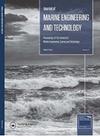将脆弱性分析集成到早期分布式海军舰艇系统设计过程中
IF 4.4
4区 工程技术
Q1 Engineering
Journal of Marine Engineering and Technology
Pub Date : 2021-10-26
DOI:10.1080/20464177.2021.1996071
引用次数: 2
摘要
摘要在分布式船舶系统设计的早期阶段,采取了减少脆弱性的措施,以确保所需系统在受损状态下的可用性。传统上,这些减少脆弱性的措施是基于过去经验的设计规则或最佳实践。因此,由于系统概念和作战环境的变化,这些措施不符合未来军舰的定义。最近开发的脆弱性评估方法能够在设计过程的早期确定设计的脆弱性。通过在早期设计过程中集成这些方法,分析结果可以用于生成不太脆弱的分布式船舶系统设计。本文提出了一种整体和整体的方法来优化设计变量和分布式网络,因为它们越来越相互依赖。这种方法的结果是生成一个模型,该模型基于预定义的系统配置和约束的物理体系结构,生成由组件位置、拓扑结构和路由连接组成的分布式船舶系统设计。使用该模型进行了五个测试案例,表明了整体和整体方法的必要性,因为现代设计规则的实施程度取决于网络复杂性和操作环境。本文章由计算机程序翻译,如有差异,请以英文原文为准。
Integrating vulnerability analysis into the early stage distributed naval ship system design process
ABSTRACT Vulnerability reduction measures are taken during the early stage distributed ship system design process to ensure the availability of the required systems in a damaged state. Traditionally these vulnerability reduction measures are based on design rules or best practices resulting from past experiences. Therefore, the measures are not per definition applicable for future warships, as both the system concepts and operational environment changes. Recently developed vulnerability assessment methods are able to determine the vulnerability of a design early in the design process. With the integration of these methods in the early stage design process, the results of the analysis can be used to generate less vulnerable distributed ship system designs. This paper proposes an integral and holistic approach to optimisation of the design variables and distributed networks as these are becoming increasingly interdependent. The result of this approach is a model which generates distributed ship system designs consisting of component positions, a topology and routed connections based on a pre-defined system configuration and constraining physical architecture. Five testcases were conducted using this model, showing the necessity of the integral and holistic approach as the extent to which the contemporary design rules are implemented depends on the network complexity and operational environment.
求助全文
通过发布文献求助,成功后即可免费获取论文全文。
去求助
来源期刊

Journal of Marine Engineering and Technology
工程技术-工程:海洋
CiteScore
5.20
自引率
0.00%
发文量
0
审稿时长
>12 weeks
期刊介绍:
The Journal of Marine Engineering and Technology will publish papers concerned with scientific and theoretical research applied to all aspects of marine engineering and technology in addition to issues associated with the application of technology in the marine environment. The areas of interest will include:
• Fuel technology and Combustion
• Power and Propulsion Systems
• Noise and vibration
• Offshore and Underwater Technology
• Computing, IT and communication
• Pumping and Pipeline Engineering
• Safety and Environmental Assessment
• Electrical and Electronic Systems and Machines
• Vessel Manoeuvring and Stabilisation
• Tribology and Power Transmission
• Dynamic modelling, System Simulation and Control
• Heat Transfer, Energy Conversion and Use
• Renewable Energy and Sustainability
• Materials and Corrosion
• Heat Engine Development
• Green Shipping
• Hydrography
• Subsea Operations
• Cargo Handling and Containment
• Pollution Reduction
• Navigation
• Vessel Management
• Decommissioning
• Salvage Procedures
• Legislation
• Ship and floating structure design
• Robotics Salvage Procedures
• Structural Integrity Cargo Handling and Containment
• Marine resource and acquisition
• Risk Analysis Robotics
• Maintenance and Inspection Planning Vessel Management
• Marine security
• Risk Analysis
• Legislation
• Underwater Vehicles
• Plant and Equipment
• Structural Integrity
• Installation and Repair
• Plant and Equipment
• Maintenance and Inspection Planning.
 求助内容:
求助内容: 应助结果提醒方式:
应助结果提醒方式:


